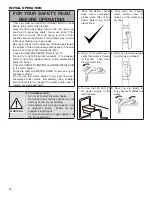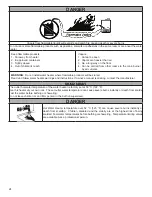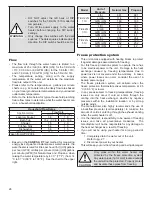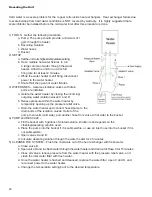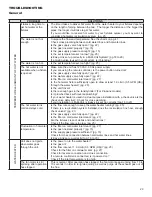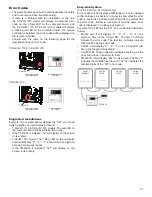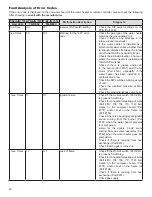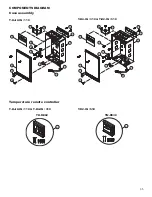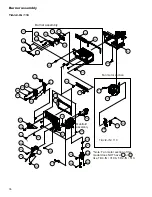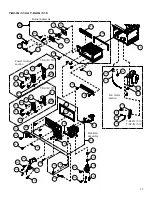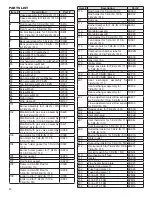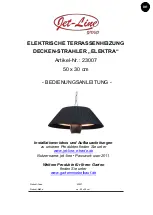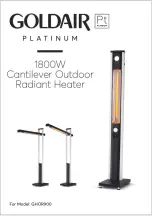
26
WARNING
•
DO NOT adjust the left bank of DIP
switches for the T-D2-IN / 510 model for
temperature .
•
Turn off the power supply to the water
heater before changing the DIP switch
settings .
•
Only change the switches with the dark
squares . The dark squares indicate which
direction the DIP switch should be set to .
Flow
•
The flow rate through the water heater is limited to a
maximum of 25 L/min (6 .6 GPM (US)) for the T-KJr2-IN
/ 110, 30 .3 L/min (8 .0 GPM (US)) for the T-K4-IN / 310,
and 37 .8 L/min (10 .0 GPM (US)) for the T-D2-IN / 510 .
•
The temperature setting, along with the supply
temperature of the water will determine the maximum
flow rate output of the unit .
•
Please refer to the temperature vs . gallons per minute
charts on pg . 42 to determine the likely flow rates based
on your local ground water temperature and your desired
outlet water temperature .
•
Refer to the table below for typical household plumbing
fixture flow rates to determine what the water heater can
do in a household application .
Household Flow Rates
Appliance/Use
Flow Rate
L/min
GPM (US)
Lavatory Faucet
3 .8
1 .0
Bath Tub
15 .2 - 37 .8
4 .0 – 10 .0
Shower
7 .5
2 .0
Kitchen Sink
5 .6
1 .5
Dishwasher
5 .6
1 .5
Washing machine
15 .2
4 .0
Taken from UPC 2006
•
Based on the
CAN/CSA P.7
test method for measuring
energy loss of gas-fired instantaneous water heaters, the
water heater is rated for litres per hour (l/hr) ((US) gallons
per hour (GPH)) or litres per minute (L/min) ((US) gallons
per minute (GPM)) for Natural Gas and Propane, when
raising the water temperature by 43 C° (77 F°) (from 14
°C to 57 °C (58 °F to 135 °F)) . See the
chart to the upper
right .
Model
Unit of
Measure
Natural Gas
Propane
T-KJr2-IN /
110
L/hr
681
681
L/min
11 .4
11 .4
GPH (US)
180
180
GPM (US)
3
3
T-K4-IN /
310
L/hr
931
931
L/min
15 .5
15 .5
GPH (US)
246
246
GPM (US)
4 .1
4 .1
T-D2-IN /
510
L/hr
954
954
L/min
15 .9
15 .9
GPH (US)
252
252
GPM (US)
4 .2
4 .2
Freeze protection system
•
This unit comes equipped with heating blocks to protect
it against damages associated with freezing .
•
For this freeze protection system to operate, there has
to be electrical power to the unit . Damage to the heat
exchanger caused by freezing temperatures due to
power loss is not covered under the warranty . In cases
where power losses can occur, consider the use of a
backup power supply .
•
The freeze protection system will activate when the
freeze protection thermostat senses temperature at 2 .5
°C (36 .5 °F) or lower .
•
In any areas subject to freezing temperatures, freezing
issues can only occur if cold air enters through the
venting into the heat exchanger, whether by negative
pressures within the installation location or by strong
outside winds .
•
The manufacturer also highly recommends the use of
a backflow preventer (sold separately) to minimize the
amount of cold air entering through the exhaust venting
when the water heater is off .
•
It is the installer’s responsibility to be aware of freezing
issues and take all preventative measures . The
manufacturer will not be responsible for any damage to
the heat exchanger as a result of freezing .
•
If you will not be using your heater for a long period of
time:
1 . Completely drain the water out of the unit .
Refer to pg . 27 .
2 . Disconnect power to your heater .
This will keep your unit from freezing and being damaged .
CAUTION
Only pipes within the water heater are
protected by the freeze protection system .
Any water pipes (hot or cold) located outside
the unit will not be protected . Properly protect
and insulate these pipes from freezing .











